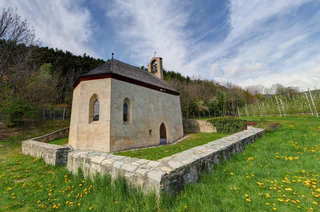
1/3
Church "St. Karpophorus"
Tarres/Tarsch, Latsch/Laces, Vinschgau/Val Venosta
Zuid-Tirol is bijzonder rijk aan verhalen die zich slingeren rond geheime locaties en ongewone natuurlijke formaties. Bezienswaardigheden, zoals de heksenbankjes op de Alpe di Siusi/Seiser Alm, vertellen verhalen van heksen en koningen, terwijl krachtplekken, zoals de "Stoanerne Mandln" met meer dan honderd cairns of de oude ruïnes op de heuvel van Castelfeder, bezoekers uitnodigen om te ontspannen en diep adem te halen. Unieke natuurlijke formaties zoals de aardpiramides zijn plaatsen die een wandeling en verkenning waard zijn.

1/3
Tarres/Tarsch, Latsch/Laces, Vinschgau/Val Venosta

Monte S. Caterina/Katharinaberg, Partschins/Parcines, Meran/Merano and environs

1/3
Glorenza/Glurns, Glurns/Glorenza, Vinschgau/Val Venosta

1/3
Merano/Meran, Meran/Merano, Meran/Merano and environs

1/2
Parcines/Partschins, Partschins/Parcines, Meran/Merano and environs

Vilpiano/Vilpian, Terlan/Terlano, Alto Adige Wine Road

Magrè s.S.d.V./Margreid a.d.W., Kurtatsch an der Weinstraße/Cortaccia sulla Strada del Vino, Alto Adige Wine Road

1/3
Fiè/Völs, Völs am Schlern/Fiè allo Sciliar, Dolomites Region Seiser Alm

1/3
Lutago/Luttach, Ahrntal/Valle Aurina, Ahrntal/Valle Aurina

1/8
Parcines/Partschins, Partschins/Parcines, Meran/Merano and environs

1/3
Sciaves/Schabs, Natz-Schabs/Naz-Sciaves, Brixen/Bressanone and environs

1/6
Terento/Terenten, Terenten/Terento, Brixen/Bressanone and environs

Tarres/Tarsch, Latsch/Laces, Vinschgau/Val Venosta

1/3
Valgiovo/Jaufental, Ratschings/Racines, Sterzing/Vipiteno and environs

La Costa/Seit, Laives/Leifers, Bolzano/Bozen and environs

S.Martino/Reinswald, Sarntal/Sarentino, Brixen/Bressanone and environs

S. Genesio Atesino/Jenesien, Jenesien/San Genesio Atesino, Bolzano/Bozen and environs

Vipiteno/Sterzing, Sterzing/Vipiteno, Sterzing/Vipiteno and environs

1/2
Sluderno/Schluderns, Schluderns/Sluderno, Vinschgau/Val Venosta

1/3
S.Martino/Reinswald, Sarntal/Sarentino, Brixen/Bressanone and environs

1/12
Andriano/Andrian, Andrian/Andriano, Alto Adige Wine Road

1/5
Colma/Kollmann, Barbian/Barbiano, Brixen/Bressanone and environs

1/2
Rio Lagundo/Aschbach, Algund/Lagundo, Meran/Merano and environs

Dobbiaco Nuova/Neutoblach, Toblach/Dobbiaco, Dolomites Region 3 Zinnen

1/3
Sesto/Sexten, Sexten/Sesto, Dolomites Region 3 Zinnen

Braies di Dentro/Innerprags, Prags/Braies, Dolomites Region 3 Zinnen

1/2
Sesto/Sexten, Sexten/Sesto, Dolomites Region 3 Zinnen

Dobbiaco Nuova/Neutoblach, Toblach/Dobbiaco, Dolomites Region 3 Zinnen

Anterivo/Altrei

1/5
Naz/Natz, Natz-Schabs/Naz-Sciaves, Brixen/Bressanone and environs